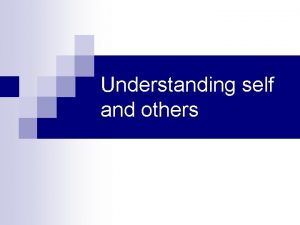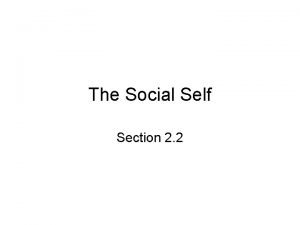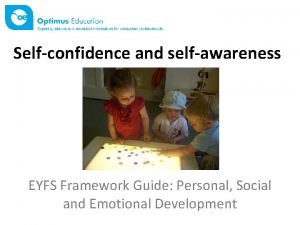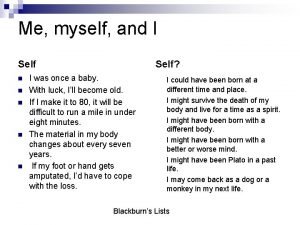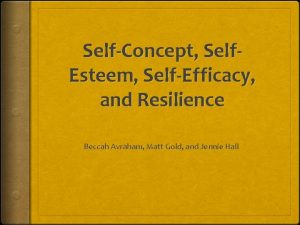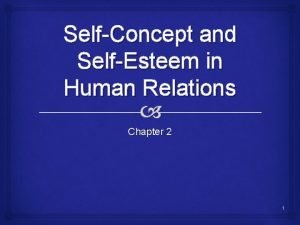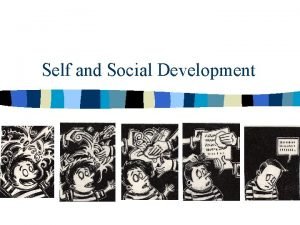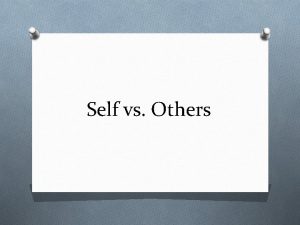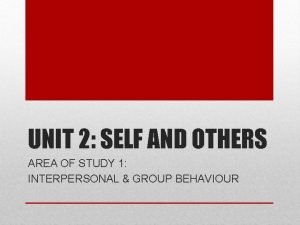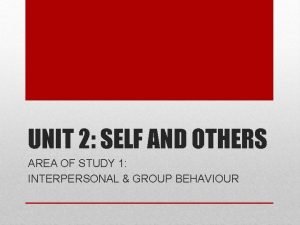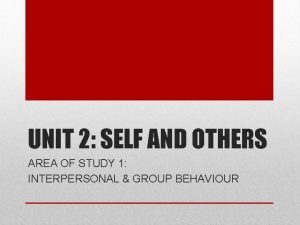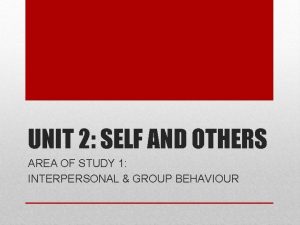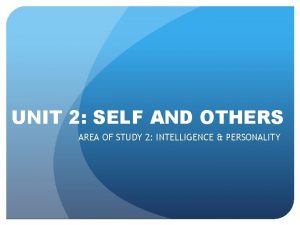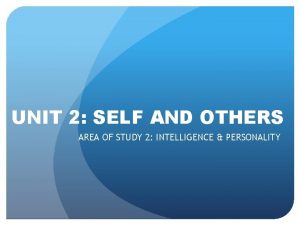UNIT 2 SELF AND OTHERS AREA OF STUDY











- Slides: 11

UNIT 2: SELF AND OTHERS AREA OF STUDY 1: INTERPERSONAL & GROUP BEHAVIOUR

FACTORS INFLUENCING RELUCTANCE TO HELP 1. DIFFUSION OF RESPONSIBILITY 1. AUDIENCE INHIBITION 1. COST-BENEFIT ANALYSIS PRO-SOCIAL BEHAVIOUR

DIFFUSION OF RESPONSIBILITY Diffusion of responsibility is the belief that, in a situation where help is required and others are present, one or more other people will or should take responsibility for helping Each individual therefore feels less responsible for helping than if they were alone This decreases the likelihood that any one person will help FACTORS INFLUENCING RELUCTANCE TO HELP

DIFFUSION OF RESPONSIBILITY Darley & Latane (1968) “Fake Epileptic Fit” • 72 University students (59 female, 13 male) • Participants placed alone in separate rooms that are connected via intercom • Participants then led to believe person in room next to them having an epileptic fit (via previously recorded sound) CONDITION 1 CONDITION 2 CONDITION 3 Participant alone Participant + 2 others Participant + 5 others 84% helped 61% helped 31% helped FACTORS INFLUENCING RELUCTANCE TO HELP

DIFFUSION OF RESPONSIBILITY Darley & Latane (1968) “Fake Epileptic Fit” FACTORS INFLUENCING RELUCTANCE TO HELP

LEARNING ACTIVITY 10. 14 HOMEWORK (pg. 434)

AUDIENCE INHIBITION Audience = the presence of others at a scene Inhibit = preventing someone from doing something (helping) Audience members check how others at the scene are reacting and that informs their own behaviour When interviewed about why people don’t help in particular situations, they often report that they didn’t want to embarrass themselves by looking too anxious, so they try to stay calm FACTORS INFLUENCING RELUCTANCE TO HELP

AUDIENCE INHIBITION Latane & Darley (1968) “Smoke-Filled Room” • 60 male University students CONDITION 1 CONDITION 2 CONDITION 3 Participant alone 1 Participant 2 Confederates 3 Participants 50% within 2 minutes 75% within 3. 5 minutes 62% did not report the smoke in 6 minutes http: //www. youtube. com/watch? v=G-l. JPds. Gdc. Q http: //www. youtube. com/watch? v=KE 5 Yw. N 4 NW 5 o FACTORS INFLUENCING RELUCTANCE TO HELP

AUDIENCE INHIBITION Latane & Darley (1968) “Smoke-Filled Room” FACTORS INFLUENCING RELUCTANCE TO HELP

COST-BENEFIT ANALYSIS Involves an individual weighing up the personal and social costs of helping against the benefits of helping BENEFITS COSTS Monetary rewards Gratitude of the victim Help in return (reciprocity) Feeling good Increase in self-esteem Social approval Thrill of helping Effort required Time required Personal injury Guilt or embarrassment Loss of resources FACTORS INFLUENCING RELUCTANCE TO HELP

LEARNING ACTIVITY 10. 15 LEARNING ACTIVITY 10. 16 HOMEWORK (pg. 436)
 Actual self definition
Actual self definition Managing self and others
Managing self and others Slidetodoc.com
Slidetodoc.com I self and me self difference
I self and me self difference Self confidence and self awareness eyfs
Self confidence and self awareness eyfs Thomas reid brave officer
Thomas reid brave officer Unit 6 review questions
Unit 6 review questions Identifying prepositional phrases
Identifying prepositional phrases Self image vs self perception
Self image vs self perception All thoughts
All thoughts Self image vs self perception
Self image vs self perception Self concept vs self esteem
Self concept vs self esteem


